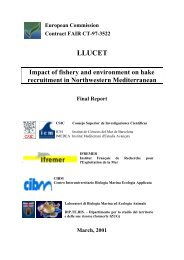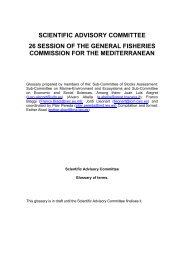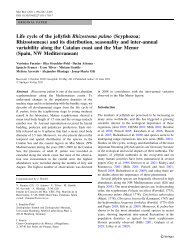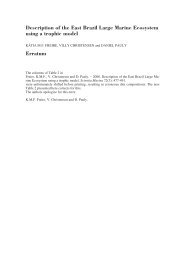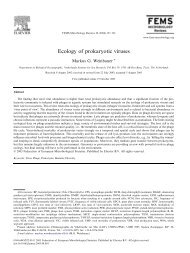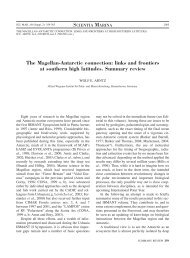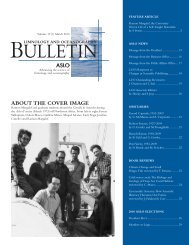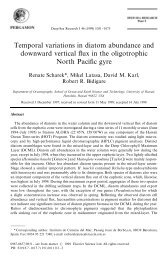REPORT OF THE WORKSHOP ON TRAWL SURVEY ... - FAO.org
REPORT OF THE WORKSHOP ON TRAWL SURVEY ... - FAO.org
REPORT OF THE WORKSHOP ON TRAWL SURVEY ... - FAO.org
Create successful ePaper yourself
Turn your PDF publications into a flip-book with our unique Google optimized e-Paper software.
year-class dynamics, the next step is to use each survey in turn to tune an XSA run, with F-<br />
shrinkage reduced to negligible amounts. All three surveys produce an assessment showing a<br />
sharp decline in F in recent years (Fig. 15), probably associated with a large increase in<br />
biomass of the 1999 year class together with measures such as increased mesh size since 2000<br />
and reductions in fleet size of UK vessels which are the main fleets targeting haddock. The<br />
IBTSQ1 survey produces the largest decline in F estimates with correspondingly larger SSB<br />
estimates (Fig. 15), possibly related to the reduced information on recent abundance of the<br />
1999 year class. None of the survey series indicate longer-term trends in catchability.<br />
All the survey data were retained for the final XSA run. Figure 16 shows that the SSB trends<br />
from the final XSA match the trends in SSB from the raw survey data (including the IBTSQ1<br />
6+ gp) except for the recent period of growth and decline of the 1999 year class. Most<br />
importantly, the three surveys provide strong evidence that SSB in 2005 and 2006 has<br />
declined much faster than indicated by the XSA. This may again be a consequence of<br />
omitting potentially influential recent survey indices for the 1999 year class from the<br />
assessment model. The historical performance of the assessment by successive Working<br />
Groups has been relatively good (Fig. 17), but has mostly been over years with less dynamic<br />
changes in the stock and the fishery.<br />
The conclusion from the North Sea haddock example is that surveys and fishery data can<br />
provide useful information on stock trends and fishing mortality when the stock is relatively<br />
stable, but extreme dynamics such as the appearance of very strong year classes can be<br />
difficult to handle in fishery-based models. The haddock example also emphasizes the need to<br />
make the most efficient use of all the available survey data that are considered reliable, which<br />
was not possible in this case because of the constraints of adopting a model (XSA) that could<br />
not handle all the available survey data after the last year with catches, and inclusion of<br />
important survey data in a plus-group that could not be included in the tuning procedure.<br />
References: papers<br />
Beare, D., Castro, J., Cotter, J., van Keeken, O., Laurec, A., Mahé, J-C., Moura, O., Munch-Petersen, S.,<br />
Nielsen, J.R., Piet, G., Simmonds, J., Skagen, D. and Sparre, P. 2003. Evaluation of Research Surveys<br />
in Relation to Management Advice. (EVARES – Fish/2001/02-Lot 1). Final Report to European<br />
Commission Director-General Fisheries. 324pp.<br />
Begley, J. and Howell, D. 2004. An overview of Gadget, the Globally applicable Area-Disaggregated General<br />
Ecosystem Toolbox. ICES CM 2004/FF:13<br />
Daan, N. 2001. The IBTS database: a plea for quality control. ICES CM 2001/T:03.<br />
Darby, C. D. 2004. Estimating systematic bias in the North Sea cod landings data. Working Document to the<br />
ICES Working Group on the Assessment of Demersal Stocks in the North Sea and Skagerrak, 7-16<br />
September 2004.<br />
Godø, O.R., Somerton, D. and Totland, A. 1999. Fish behaviour during sampling as observed from free floating<br />
buoys – application for bottom trawl survey assessment. ICES CM 1999/J:10.<br />
Gudmundsson, G. 1994. Time series analysis of catch-at-age observations. Appl. Statist (1994) 43(1):117-126<br />
Lewy, P., Nielsen, J.R. and Hovgard, H. 2004. Survey gear calibration independent of spatial fish distribution.<br />
Can. J. Fish. Aquat. Sci. 61: 636-647.<br />
Mesnil, B. 2003. The Catch-Survey Analysis (CSA) method of fish stock assessment: an evaluation using<br />
simulated data. Fish. Res. 63(2): 193-212.<br />
Needle, C.L. 2005. SURBA 3.0 Technical Manual (first draft) Fisheries Research Services, Marine Laboratory,<br />
Aberdeen. 10pp.<br />
Patterson, K.R. 1997. Integrated catch at age analysis. Version 1.4. User’s manual. FRS Marine Laboratory,<br />
Aberdeen, Scotland.<br />
Pennington, M and Nakken, O. 2006. Timely evaluation of stock status based on scientific surveys, an update.<br />
ICES CM 2006/I:12.<br />
56




